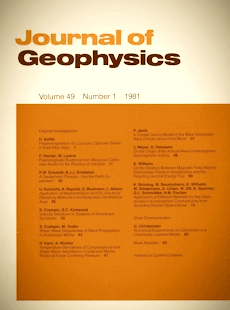Velocity variations in systems of anisotropic symmetry
Article Sidebar

Vols. 1-18 (1924-1944), ISSN 0044-2801
Main Article Content
Abstract
Angular variations of seismic velocities have been observed in the Earth and attributed to some form of anisotropy caused by aligned crystals, orientated cracks and inclusions, and laminated strata. The exact analytical expressions for the velocities in each particular symmetry-system, derived from the Kelvin-Christoffel equations, are complicated functions of the elastic constants and cannot be easily manipulated. This paper examines the form of the velocity variations for the several systems of elastic symmetry; five of these seven symmetry-systems have been suggested for possible Earth structures. We shall demonstrate that the approximate equations of Backus (1965) and Crampin (1977 a) are good estimates for the velocity variations in symmetry planes of all symmetry systems, but not in general for off-symmetry planes. These equations are linear in the elastic constants, and provide a convenient link between velocity variations and elastic constants, if used judiciously. The behaviour of shear waves in off-symmetry directions is complicated by pinches, caused by the proximity of shear-wave singularities, where the two shear-waves exchange polarizations. Despite the restrictions to their use, the equations are the fundamental relationship for a number of modelling studies.
 ARK: https://n2t.net/ark:/88439/y036503
ARK: https://n2t.net/ark:/88439/y036503
Permalink: https://geophysicsjournal.com/article/109
Article Details
References
Ave Lallemant, H.G., Carter, N.L. (1970) Syntectonic recrystallization of olivine and modes of flow in the upper mantle. Geol. Soc. Am. Bull. 81:2203-2220
Backus, G.E. (1962) Long-wave elastic anisotropy produced by horizontal layering. J. Geophys. Res. 67:4427-4440
Backus, G.E. (1965) Possible forms of seismic anisotropy in the uppermost mantle under oceans. J. Geophys. Res. 70:3429-3439
Backus, G. (1970) A geometrical picture of anisotropic elastic tensors. Rev. Geophys. Space Phys. 8:633-671
Bamford, D. (1977) Pn velocity anisotropy in a continental upper mantle. Geophys. J. R. Astron. Soc. 49:29-48
Bamford, D., Jentsch, M., Prodehl, C. (1979) Pn anisotropy studies in Northern Britain, and the Eastern and Western United States. Geophys. J. R. Astron. Soc. 57:397-429
Bamford, D., Nunn, K.R. (1979) In situ seismic measurements of crack anisotropy in the Carboniferous limestone of Northwest England. Geophys. Prospect. 27:322-338
Bateman, T.B. (1962) Elastic moduli of single-crystal zinc oxide. J. Appl. Phys. 33:3309-3312
Bechman, R. (1958) Elastic and piezoelectric constants of alpha-quartz. Phys. Rev. llO:1060-1061
Crampin, S. (1976) A comment on "The early structural evolution and anisotropyof the oceanic upper-mantle" Geophys. J. Astron. Soc. 46:193-197
Crampin, S. (1977a) A review of the effects of anisotropic layering on the propagation of seismic waves. Geophys. J. R. Astron. Soc. 49:9-27
Crampin, S. (1977b) Palaeoanisotropy in the upper mantle. Nature 270:162-163
Crampin, S. (1978) Seismic-wave propagation through a cracked solid: polarization as a possible dilatancy diagnostic. Geophys. J. R. Astron. Soc. 53:467-496
Crampin, S., Bamford, D. (1977) Inversion of P-wave velocity anisotropy. Geophys. J. R. Astron. Soc. 49:123-132
Crampin, S., King, D.W. (1977) Evidence for anisotropy in the upper-mantle beneath Eurasia from the polarization of higher-mode seismic surface-waves. Geophys. J. R. Astron. Soc. 49:59-85
Crampin, S., McGonigle, R., Bamford, D. (1980) Estimating crack parameters from observations of P-wave velocity-anisotropy. Geophysics 45:345-360
Crampin, S., Yedlin, M. (1981) Shear-wave singularities in wave propagation in anisotropic media. J. Geophys. 49:43-46
Forsyth, D.W. (1975) The early structural evolution and anisotropy of the oceanic upper-mantle. Geophys. J. R. Astron. Soc. 43:103-162
Francis, T.J.G. (1969) Generation of seismic anisotropy in the upper mantle along the mid-oceanic ridges. Nature 221:162-165
Hess, H. (1964) Seismic anisotropy of the uppermost mantle under oceans. Nature 203:629-631
Kaarsberg, E.A. (1968) Elasticity studies of isotropic and anisotropic rock samples. Trans. Soc. Min. Eng. 241:470-475
Kirkwood, S.C. (1978) The significance of isotropic inversion of anisotropic surface-wave dispersion. Geophys. J. R. Astron. Soc. 55:131-142
Kirkwood, S.C., Crampin, S. (1980a) Surface-wave propagation in an ocean basin with an anisotropic upper-mantle: numerical modelling. Geophys. J. R. Astron. Soc. (In press)
Kirkwood, S.C., Crampin, S. (1980b) Surface-wave propagation in an ocean basin with an anisotropic upper mantle: observations of polarization anomalies. Geophys. J. R. Astron. Soc. (In press)
Kumazawa, M. (1969) The elastic constants of single-crystal orthopyroxene. J. Geophys. Res. 74:5973-5980
Levin, F.K. (1978) The reflection, refraction, and diffraction of waves in media with an elliptical velocity dependence. Geophysics 43:528-537
McSkimin, H.J. (1953) Measurement of elastic constants at low temperature by means of ultrasonic waves - data for silicon and germanium single crystals, and for fused silica. J. Appl. Phys. 24:988-997
Musgrave, J.J.P. (1970) Crystal acoustic. Holden-Day, San Francisco
National Lead Company (1967) Physical Properties of Stoichiometric Rutile (Ti02), Titanium Div. Res. Lab., South Amboy, New Jersey
Nye, J.F. (1957) Physical properties of crystals. Oxford University Press, London
Postma, G.W. (1955) Wave propagation in a stratified medium. Geophysics 20:780-806
Raitt, R.W., Shor, G.G., Francis, T.J.G., Morris, G.B. (1969) Anisotropy of the Pacific upper-mantle. J. Geophys. Res. 74:3095-3109
Synge, J.L. (1957) Elastic waves in anisotropic media. J. Math. Phys. 35:323-334











